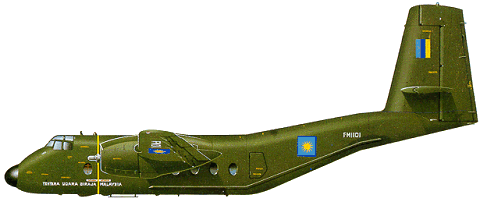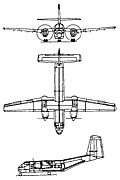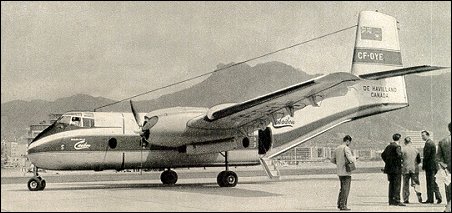|
| The decision to build the de Havilland Canada DHC-4 Caribou was taken in 1956, the object being to develop an aircraft combining the load-carrying capability of the Douglas DC-3 with the STOL performance of the Beaver and Otter. The Canadian army placed an order for two and the US Army followed with five, the US Secretary of Defense waiving a restriction which limited the US Army to fixed-wing aircraft with an empty weight less than 2268kg.
The prototype flew in July 1958, its high wing having a characteristic centre-section with marked anhedral. The rear door was designed as a ramp for items weighing up to 3048kg. In the trooping role up to 32 soldiers could be carried. The Caribou served with the RCAF as the CC-108 and with the US Army as the AC-1 (1962 designation CV-2A). As a result of its evaluation of the first five aircraft the US Army adopted the Caribou as standard equipment and placed orders for 159.
The second batch of aircraft was designated CV-2B. Following tension on the border between China and India, the US Army handed over two Caribous to the Indian Air Force in early 1963. In January 1967 the 134 Caribous still in service with the US Army were transferred to US Air Force charge as C-7A and C-7B transports. The aircraft was a general sales success and examples flew not only with air forces throughout the world, but also with civil operators. In Canadian service the Caribou was replaced by the DHC-5 Buffalo and surplus examples were sold to a number of nations including Colombia, Oman and Tanzania. Many of the Canadian aircraft had been loaned to the United Nations, seeing extensive international service. Production ended in 1973. The DHC-4A model supplanted the DHC-4 on the production line from aircraft no. 24: the two models are very similar apart from the later model's increase in weight, maximum take-off weight of the DHC-4 being 11793kg. Total production was 307.

| MODEL | DHC-4A Caribou |
| CREW | 2 |
| PASSENGERS | 32 |
| ENGINE | 2 x Pratt & Whitney R-2000-7M Twin Wasp, 1081kW |
| WEIGHTS |
| Take-off weight | 12927 kg | 28499 lb |
| Empty weight | 8283 kg | 18261 lb |
| DIMENSIONS |
| Wingspan | 29.15 m | 96 ft 8 in |
| Length | 22.12 m | 73 ft 7 in |
| Height | 9.68 m | 32 ft 9 in |
| Wing area | 84.72 m2 | 911.92 sq ft |
| PERFORMANCE |
| Max. speed | 348 km/h | 216 mph |
| Cruise speed | 293 km/h | 182 mph |
| Ceiling | 7560 m | 24800 ft |
| Range w/max payload | 389 km | 242 miles |
 | A three-view drawing (592 x 887) |
| Noname, 31.03.2020 10:24 Thanks to Cananda and Australia for partnering with us. reply | | Ed Madigan, e-mail, 05.05.2011 04:55 After coming from B-52's in Sac, flying the bou in Nam was a real treat. Got an airplane in the morning you could strap on and have some fun with. Serving the Army was a pleasure and an honor. Got to work with the 5th Special Forces in the Delta, air land and air drop supplies. Good airplane, great crews and a damn rewarding mission. 536th TAS 67 /68 Vung Tau RVN reply | | Joseph Tedeschi, e-mail, 10.04.2011 00:24 Was one of fortunate survivors of crash of C-7 into Hong Kong Mountain at An Khe on 4 Oct 1966. Thirteen were killed including air crew. Blinding fog and we flew right into mountain. Tree took off right wing and we augered in upside down. No explosion or fire. This tough airplane saved my life. I was med-evaced with broken hip, and never got to know full story and details of crash. Anyone have any info? reply |
| Rodger Harrington, e-mail, 11.03.2011 17:16 I was lucky enough to have been crew chief on one of the caribous (AC-1) that comprised the 187th Trans Airplane Company,11th Air Assault at Ft. Benning tail number 62-4155. Spent many hours flying accross the state at tree top level from Benning to Camp Stewart developing low level flight concept to be used in Nam. I have been able to find a program for my flight simulator from AlphaSim that is almost identical to the aircrafts performance, sounds and replicates everything from the cock-pit to the loading ramp. I still have many fond memories of that time in my life. It was trully a great aircraft that proved itself and I can see why the Air Force did not enjoy competing with the Army and ended up taking it as one of its own. reply | |
| | Joseph W. Hazen, e-mail, 05.03.2011 20:14 I flew the Caribou for Air America in Southeast Asia, mostly Laos, from August 1962 to April 1966. A very reliable and comfortable aircraft. In one 7 day period, I made 115 takeoffs and landings, 37 the most in one day. I bet that is a record. reply | | pete castillo, e-mail, 21.02.2011 17:47 I was assigned to the 483rd TAW between Oct '68 thru Oct 69. My job mainly consisted of loading and off-loading the C7A during the morning. The Bou would then fly on to Vung Tau and back to home base. Loved to be part of history.
Msgt Pete Castillo
TX 92nd AFJROTC
Eagle Pass,TX reply | | pete castillo, e-mail, 21.02.2011 17:46 I was assigned to the 483rd TAW between Oct '68 thru Oct 69. My job mainly consisted of loading and off-loading the C7A during the morning. The Bou would then fly on to Vung Tau and back to home base. Loved to be part of history.
Msgt Pete Castillo
TX 92nd AFJROTC
Eagle Pass,TX reply | | Dave Sandelin, e-mail, 04.02.2011 17:25 I was an ARDF operator on a Caribou in Vietnam '66-'67. It was called the Pathfinder, as we had innovative equipment that was being proven, and which was added to later aircraft. The thing could land on a dime, and give you nine cents change. W /O John (Big John) Brazil was the pilot, and between his skill and the wonderful design of the Caribou, I loved the plane. reply | | Jerry Pankonen, e-mail, 10.11.2010 07:04 I was part of the initial cadre of Air Force (AF) pilots that replaced Army pilots at Vung Tau from late August of 1966. AF headquarters rushed to find anyone from desk jockey to jet pilot to fill the Caribou crew member slots. This pot-pourri of pilots were sent to Ft Benning to be trained by the Army; then to jungle survival, and for me on to Vung Tau, Vietnam to fight the war. Luck of the draw to get Vung Tau, an in country R and R location for the GI's and Viet Cong. One hell of a great experience to fly, train and live (until they kicked us out) with Army Warrant Officers. I transitioned from the fast T-38 /C-141 to the very slow Bou. Army taught me to stop my descent when I saw the tops of trees; radio beacon timed precision approaches; and special VFR approaches to Saigon in IFR conditions. Ahhh yes those were the good old days. Learned to love the caribou. It took hits and just kept on going. Many great memories of the Bou, the guys that flew them, flight mechs /load masters, and the maintenance guys. We were all in this mess together and made the best of a bad situation. A one of a kind experience for me and one that I would not trade for anything. reply | | Jay Baker, e-mail, 10.11.2010 01:29 I was stationed in Vietnam from late August 1966- August 1967. I was not a pilot but a maintenance officer and I cut my teeth on this aircraft and raelly enjoyed the experience. I was part of the initial cadre that transitioned the Army CV-2 to the Air Force in 1967. A perfect logistical aircraft in support of remote sites. reply | | Jake, e-mail, 30.09.2010 05:46 They were P & W R-3000
Have 1100 hours in VN in 69 and 70. First LT IP without extending
More fun flying than I ever had before of since.
It would do anything you asked and still more to come. reply | | Timothy Dillon, e-mail, 28.09.2010 06:33 I was a crew chief in Nam 68-69 on the Bou.An absolutely terrific aircraft.Would get you in and out of anywhere.The pilots and ground crews were the best.Would still be of great use today reply | | Preston Greene, e-mail, 15.05.2010 16:24 Palm Beach Aviation purchased the first DHC4A-T from PenTurbo and have operated it for the past 18 months supporting USG military pratroop training and UN relief support to Haiti. re-motored with the PT6-67 motor elimitated the problems associated with the round motored version. Is truely a workhorse now. We have first right of refusal for number two and three Turbo Caribou's from PenTurbo. Go to Penturbo.com and AC show is our Turbo Caribou. Preston reply | | Ashton Lawrence, e-mail, 30.01.2010 20:13 Twice ferried the caribou across the Pacific to Viet Nam in 1965, and flew it throughout Viet Nam on military and USAID /USOM missions until I helped transfer it to the Air Force. Fantastic machine; we could take it about anywhere reply | |
| | David Lamb, e-mail, 17.01.2010 03:50 We had 3 Caribous in Egypt in 1967 prior to the Middle East 6 Day War. It was an exciting time. The UN was dismissed and we ferried them back to Canada. I then flew one for a year with the United Nations Military Observer Group India and Pakistan. It was the ideal aircraft for the Himalaya Mountains. We worked into short fields at high elevations. We flew by K2 mountain at 28,000 ft one day sucking O2. The mountain top was still above us at 28,251 ft. Great aircraft although the engine was a little weak. 5 times I came home with one feathered. reply | | Paul sheather, e-mail, 15.01.2010 13:45 They have just retired the DH4C and i hope that HARS or temora flying museums. i think the RAAF still had 13 aircraft still flying and it would be a shame not any of them flying. reply | | W. Schulte, e-mail, 20.12.2009 05:46 Served in Vietnam 1965 with 5th SFG based in Nha Trang. We were transported to and from many A camp sites aboard Caribous which were expertly flown by Aussie pilots. i believe they could take off and land on a football field. They saved our bacon more times than I can count. Thanks to Cananda and Australia for partnering with us. reply | | Tony Chapa, e-mail, 09.12.2009 03:07 I flew the Caribou 1964-1967 at Fort Rucker, Alabama. I loved it and wish I had an opportunity to fly one again. reply | | B. Farmer, e-mail, 24.09.2009 18:05 flew as flight engineer on the bou in viet nam. Was a great aircraft. She did what was asked of her. Noisy or not loved the ole girl. reply | | agustin f jose, e-mail, 16.08.2009 19:57 hi just wondering if you could send me details on the a /c performance.we have one in the philippines and we're taking it to djibouti,africa soon (i wonder how long will it take us to reach africa) to do the djibouti-dubai run...thank you reply |
|
Do you have any comments?
|
| 
COMPANY
PROFILE
All the World's Rotorcraft
|









20
reply